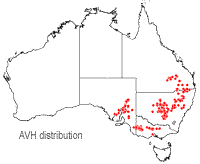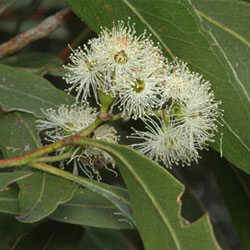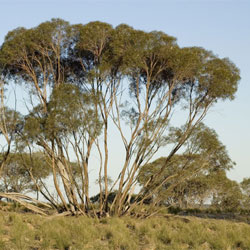Eucalyptus viridis
Green Mallee, Green Mallee Box
Eucalyptus viridis is commonly known as Green Mallee due to the leaves which are usually a dark, intense, lustreless green. This plant can either be a shrub or small tree growing between approximately 2 to 9m tall. It has a lignotuber with one to many trunks. The stem width varies between 6 and 19cm. The bark at the base of the stems is box and the remainder is gum. The leaves are narrow, approximately 0.8cm wide and the length is less than 12cm, though in Queensland some have been recorded as 1.3cm wide and 13.5cm long. The lateral veins are faint and the oil glands are prominent.
 This species of eucalypt has a disjunct distribution in semi-arid regions of south-eastern Australia. It occurs in four states: in the north-western and central slopes and plains of New South Wales e.g. Cobar; South Australia eg. in the Flinders Ranges; in the middle and mid-north of Victoria e.g. Bendigo; and in southern Queensland e.g. near Inglewood.
This species of eucalypt has a disjunct distribution in semi-arid regions of south-eastern Australia. It occurs in four states: in the north-western and central slopes and plains of New South Wales e.g. Cobar; South Australia eg. in the Flinders Ranges; in the middle and mid-north of Victoria e.g. Bendigo; and in southern Queensland e.g. near Inglewood.
Green Mallee generally grows in areas with low rainfall, high summer temperatures and few winter frosts, but also grows well in southern temperate areas. It can be found in a wide range of soils, from poorly drained clays to well drained sand. This tree is very hardy once established and has a high drought resistance. Where the climate is hot and dry it can be used as a low windbreak. Dense thickets can form on stony ridges and loamy-clayey soils. These thickets can be useful as stock shelter. A wildlife corridor may be created if a shelterbelt links existing habitats. When this species is protected from fire, stock and is planted on good soil a small bushy tree may develop. The low growth and low water requirements make it suitable to be used as a street tree.
This species is used in some New South Wales gardens. The leaves have a significantly different colouration to other eucalypts. The fruit varies in size between 3.5-6mm x 3-5mm, the largest fruits are found on some trees in Queensland and New South Wales. The flowers are creamy-white and can be abundant. Flowering times vary greatly. The main time in the four states is spring to summer, and they occasionally return again in June. Some New South Wales and Victorian plants flower during August, while some others in New South Wales and Queensland flower during March.
The plant habit can be manipulated to a degree. In cultivation it may become a tree form rather than a multi-stemmed mallee form, due to extra nutrients and water. This can be altered by coppicing, burning or growing it under more natural conditions. Planting it in a garden may increase the wildlife as the flowers attract insects and nectar eating birds. Small shrubs could be grown under the tree in a garden situation as it usually has an open habit.
Propagation is from seed which can be collected throughout the year. It does not need to be pre-treated and should be kept in an air tight container at room temperature. This species germinates readily. If the conditions suit and there is enough seed available it can be direct seeded.
Green Mallee is a big honey producer in New South Wales, and it is an important eucalypt used for the distillation of essential oils.
Text: Clare Vincent (2010 Student Botanical Intern)
Name Meaning: Eucalyptus viridisEucalyptus – from the Greek eu, meaning well, and kalyptos, meaning covered. This refers to the operculum covering the flower buds. viridis – from the Latin viridis meaning green. This refers to the leaves. |
References
Council of Heads of Australian Herbaria (CHAH) (2010) Australia’s Virtual Herbarium. http://www.ersa.edu.au/avh/
Baker, R.T. (1900) On Some New Species of Eucalyptus, The Proceedings of the Linnaean Society of New South Wales 25: 303-320
Blakely, W.F. (1965) A key to the eucalypts: with descriptions of 522 species and 150 varieties, 3 rd edition. Forestry and Timber Bureau, Canberra.
Brooker, M.I.H. & Kleinig, D.A. (2006) Field Guide to Eucalypts – Vol 1 South-eastern Australia. Blooming Books Pty Ltd, Melbourne.
Brunskill, S. (compiler) (2008) A selection of indigenous plants of Albury Wodonga & surrounds. Student booklet. TAFE NSW- Riverina Institute National Environment Centre.
Cremer, K.W. (1990) Trees for rural Australia. CSIRO Division of Forestry and Products. Inkata Press, Melbourne.
Cunningham, G.M., Mulham, M.E., Milthorpe, P.L. and Leigh, J.H. (1992) Plants of Western New South Wales. Inkata Press, Melbourne.
Elliot, W.R. and Jones, D.L. (1986) Encyclopaedia of Australian plants: suitable for cultivation Vol 4. Lothian Publishing Company, Melbourne.
Forestry Commission of New South Wales (1980) Trees and Shrubs for Eastern Australia. New South Wales University Press, Kensington.
Hall, N., Bowden, R., Christian, C.S., Condon, R., Dale, F., Hart, A., Leigh, J., Marshall, J., McArthur, A., Russell, V. & Turnbull, J. (1972) The use of trees and shrubs in the dry country of Australia. Australian Government Publishing Service, Canberra.
Hall, N., Johnston, R.D. & Marryatt, R. (1963) The natural occurrence of the Eucalypts, 2 nd edition. Forestry and Timber Bureau, Canberra.
Kelly, K., Chippendale, G.M. & Johnston, R.D. (1969) Eucalypts. Nelson, Australia.
Kent , K., Earl, G., Mullins, B., Lunt, I. & Webster, R. (eds) (2002) Native Vegetation Guide for the Riverina: notes for land managers on its management and revegetation. Johnstone Centre, Charles Sturt University, Wagga Wagga. Available at http:// www.csu.edu.au/herbarium/riverina/ .
McMahon, D. S. (1990) Eucalypts for enthusiasts: a guide to the identification of eucalypts found in south-eastern Australia. D. McMahon, Fitzroy, Victoria.
Ralph, M. (2003) Growing Australian native plants from seed for revegetation tree planting and direct seeding, 2 nd edition. Murray Ralph/Bushland Horticulture, Fitzroy.
Seedbank Coordinators of the Goulburn Broken Indigenous Seedbank & the North East Community Seedbank (2004) N ative plant seed in the Goulburn Broken Catchment . Goulburn Broken Indigenous Seedbank and North East Community Seedbank Available at http://www.dookie.unimelb.edu.au/files/Seedbank.pdf
Rodd, T. & Cundall, P. (2005) Flora’s trees & shrubs: Illustrated A-Z of over 8500 plants. ABC Gardening Australia. ABC Books.
Stanley, T.D. & Ross, E.M. (1986) Flora of south-eastern Queensland Vol 2. Queensland Department of Primary Industries, Brisbane.
Stewart, D. & Stewart, R. (2008) From seeds to leaves: a complete guide to growing Australian shrubs and trees from seed. Black Inc., Melbourne.
Taylor , D. (2010) Australian National Botanic Gardens, pers. comm.
Wrigley, J.W. & Fagg, M. (2003) Australian native plants: cultivation, use in landscaping and propagation, 5 th Edition. Reed New Holland, New South Wales.
![An Australian Government Initiative [logo]](/images/austgovt_brown_90px.gif)



